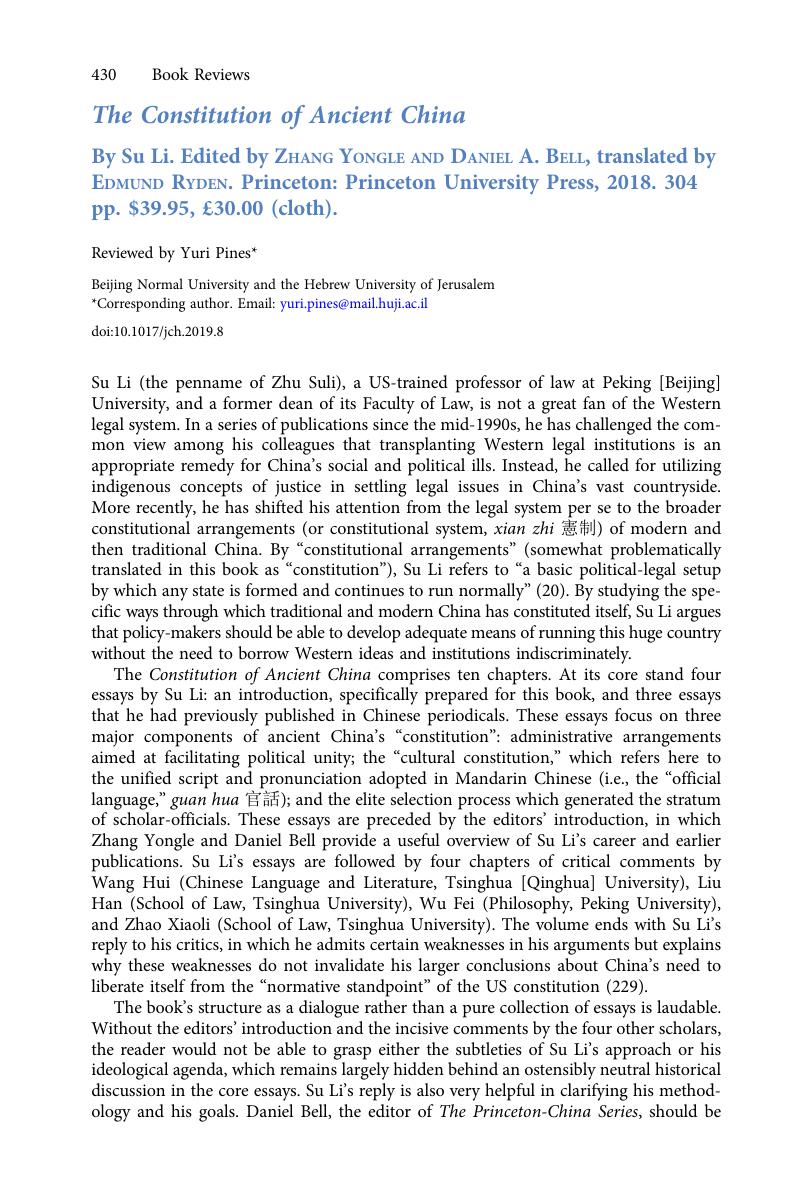Article contents
The Constitution of Ancient China By Su Li. Edited by Zhang Yongle and Daniel A. Bell, translated by Edmund Ryden. Princeton: Princeton University Press, 2018. 304 pp. $39.95, £30.00 (cloth).
Review products
Published online by Cambridge University Press: 29 August 2019
Abstract

- Type
- Book Review
- Information
- Journal of Chinese History 中國歷史學刊 , Volume 3 , Special Issue 2: History of Material Culture , July 2019 , pp. 430 - 437
- Copyright
- Copyright © Cambridge University Press 2019
References
1 For the translation of Zou Rong's Revolutionary Army (Geming jun 革命軍), see Lust, John, The Revolutionary Army: A Chinese Nationalist Tract of 1903 (Paris: Mouton, 1968)Google Scholar.
2 For “totalistic iconoclasm,” see Lin, , Yü-sheng, , The Crisis of Chinese Consciousness: Radical Antitraditionalism in the May Fourth Era (Madison: University of Wisconsin Press, 1979)Google Scholar.
3 For a summary of pre-1990 studies, see Fenghan, Zhu 朱鳳瀚 and Yong, Xu 徐勇, eds, Xian Qin shi yanjiu gaiyao 先秦史研究概要 (Tianjin: Tianjin jiaoyu, 1996), 142–45Google Scholar. For later studies, see relevant parts of Yanjiusuo, Zhongguo Shehui Kexueyuan Kaogu 中國社會科學院考古研究所, Zhongguo kaoguxue: Xia Shang juan 中國考古學:夏商卷 (Beijing, Zhongguo Shehui kexue chubanshe, 2003)Google Scholar and Shelach, Gideon and Jaffe, Yitzhak, “The Earliest States in China: A Long-Term Trajectory Approach,” Journal of Archeological Research 22.4 (2014), 327–64CrossRefGoogle Scholar; q.v. for further references.
4 Wittfogel, Karl A., Oriental Despotism: A Comparative Study of Total Power (New Haven: Yale University Press, 1957)Google Scholar.
5 Recall that the Yellow River problems started only on the eve of imperial unification, because of excessive development along its middle course in the Loess Plateau. See Elvin, Mark, The Retreat of the Elephants: An Environmental History of China (New Haven: Yale University Press, 2004), 24Google Scholar, and the more detailed study in Chen, Yunzhen et al. , “Socio-economic Impacts on Flooding: A 4000-Year History of the Yellow River, China” AMBIO 41.7 (2012), 682–98CrossRefGoogle Scholar.
6 See Cosmo, Nicola Di, Ancient China and Its Enemies: The Rise of Nomadic Power in East Asian History (Cambridge: Cambridge University Press, 2002)CrossRefGoogle Scholar.
7 For my argument, see more in Pines, Yuri, The Everlasting Empire: Traditional Chinese Political Culture and Its Enduring Legacy (Princeton: Princeton University Press, 2012)Google Scholar.
8 For the dating of the Rituals of Zhou, see, e.g., Lin, Peng 彭林, “Zhou li” zhuti sixiang yu chengshu niandai yanjiu 《周禮》主題思想與成書年代研究 (Beijing: Zhongguo shehuikexue, 1991)Google Scholar. For the usages of the text throughout history, see the essays in Elman, Benjamin A. and Kern, Martin, eds, Statecraft and Classical Learning: The “Rituals of Zhou” in East Asian History (Leiden: Brill, 2010)CrossRefGoogle Scholar.
9 Feng, Li, Landscape and Power in Early China: The Crisis and Fall of the Western Zhou, 1045–771 BC (Cambridge: Cambridge University Press, 2006)CrossRefGoogle Scholar; for the Chinese translation, see Feng, Li 李峰, Xi Zhou de miewang: Zhongguo zaoqi guojia de dili he zhengzhi weiji 西周的滅亡:中國早期國家的地理和政治危機 (Shanghai: Shanghai guji chubanshe, 2007)Google Scholar. Reading Li Feng—and coming to terms with Su Li's own correct recognition that the Western Zhou “had not yet become a complete territorial state” (46)—would also have helped him avoid the misleading assertion that the Zhou territory comprised “1.5 million square kilometers.”
10 For an introductory discussion, see Van De Mieroop, Marc, A History of the Ancient Near East ca. 3000–323 BC, third edition (Chichester: Wiley Blackwell, 2016)Google Scholar.
11 Su Li ignores the existence of the Arab Caliphate and of early Indian empires. For India, he claims that the first empire was established by the “Turkic Mongol people,” i.e., the Mughals (21). It seems that the author is unaware of the Maurya empire (fourth–third century BCE), despite the fact that its most illustrious ruler, Aśoka (d. ca. 232 BCE) is a celebrated figure in Chinese Buddhism (under the name of King Ayu 阿育王).
12 For example, his odd claim that China is “the only continuously existing ancient civilization in human history” (215). Has he not heard of Indian (or Jewish) civilization?
13 See Tong, James W., Disorder under Heaven: Collective Violence in the Ming Dynasty (Stanford, CA: Stanford University Press, 1991)Google Scholar (for peasant uprisings); Robinson, David, Bandits, Eunuchs, and the Son of Heaven: Rebellion and the Economy of Violence in Mid-Ming China (Honolulu: University of Hawai'i Press, 2001)Google Scholar (for banditry); Huang, Ray, 1587, A Year of No Significance: The Ming Dynasty in Decline (New Haven: Yale University Press, 1981), 163–66Google Scholar (for the Japanese pirates’ menace); Rossabi, Morris, “The Ming and Inner Asia,” in The Cambridge History of China, Volume 8: The Ming Dynasty, Part 2: 1368–1644 (Cambridge: Cambridge University Press, 1988), 221–71Google Scholar (for the relations with the Mongols).
14 For the transformation of the Christian and the Islamic worlds from unified empires (the Roman Empire and the Caliphate) into commonwealths, see Fowden, Garth, Empire to Commonwealth: Consequences of Monotheism in Late Antiquity (Princeton: Princeton University Press, 1993)Google Scholar.
15 For example, a Han exegete, Zheng Xuan 鄭玄 (127–200) is referred to by his personal name on p. 162, but by his appellative (zi 字), Kangcheng 康成 on pp. 193 and 196. The letter ü is normally written correctly, but from time to time it becomes “u” (257n24) or, oddly, “ui” (241n36), and so forth.
- 1
- Cited by


